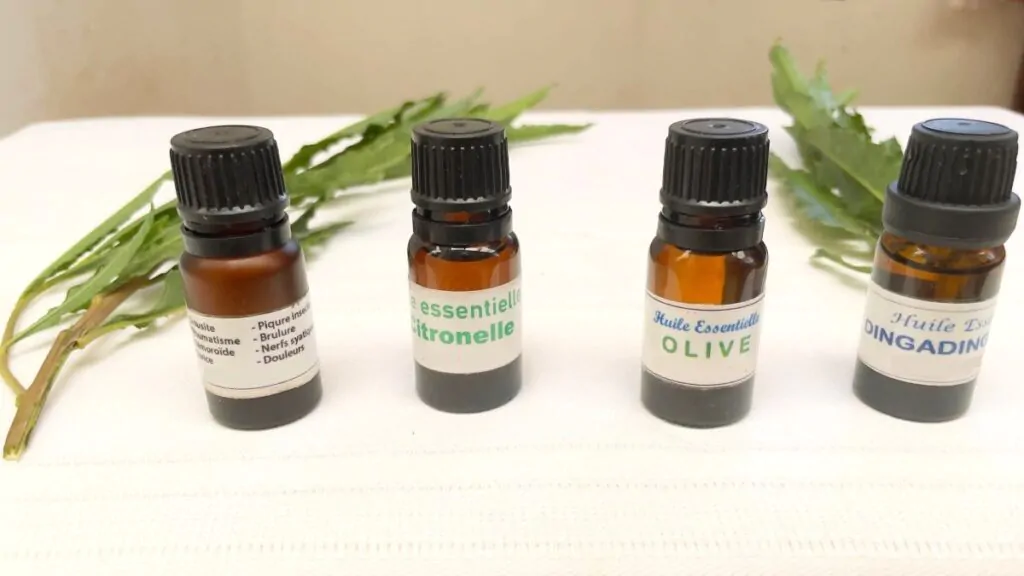Dingadingana (Psiadia altissima, also known as Iary of Madagascar) is a plant endemic to Madagascar and holds a central place in traditional Malagasy medicine. Used by our grandmothers for its versatile therapeutic benefits, this shrub is gaining attention today for its effectiveness against skin, digestive, and respiratory conditions.
Traditional Uses of Dingadingana
A Versatile Remedy for the Skin
Dingadingana is renowned for treating skin issues such as eczema, persistent scars, and itching. Its leaves, rich in active compounds, are applied as a poultice to cleanse wounds and speed up healing. Skin infections like scabies (locally known as lagaly) or purulent pimples are also alleviated due to its antibacterial properties. For children, a light infusion of its leaves gently cleanses irritations without side effects.
Solutions for Internal Ailments
In decoction, Dingadingana combats liver disorders (locally referred to as aretin’aty) and digestive issues. Drinking a daily cup of fresh leaf infusion regulates bile functions and reduces intestinal inflammations. It also provides relief for chronic cough and asthma through its expectorant properties. A preparation of boiled leaves in water, filtered and consumed warm, clears the respiratory tracts within a few days.
An Ally Against Everyday Discomforts
Dingadingana leaves eliminate persistent body odors. A localized bath with a concentrated infusion neutralizes underarm odors (locally known as fofonkelika) in just three minutes. Additionally, massaging the scalp with its juice stimulates hair growth and reduces dandruff. For the feet, a daily foot bath prevents fungal infections and softens the skin.
Preparations and Application Methods
Decoctions and Infusions of Dingadingana
The most common method is boiling the leaves in water. For children under 2 years, 10 leaves infused in 1 liter of water are sufficient. For those over 2 years, the quantity of leaves and water is doubled. The decoction is filtered after 40 minutes of boiling and can be applied as a compress or drunk depending on the ailment. A treatment course of 2 to 5 days is generally recommended for lasting results.
Targeted Topical Applications
For skin problems, the leaves are crushed to obtain a thick juice, which is applied directly to the affected areas, such as pimples or wounds, and left to dry in the open air. For scars, applying it morning and evening for 48 hours visibly reduces marks. In case of insect bites, a quick rub with a crumpled leaf immediately soothes the pain.
Specific Uses for Children
Infants with skin rashes (locally known as farasisa) benefit from a warm bath enriched with Dingadingana infusion. The leaves are first soaked in boiling water, cooled, and mixed with the bath water. For colds, inhaling the steam from a hot decoction clears the sinuses. Caution: dosages must be strictly followed to avoid irritations.
Dingadingana in Malagasy Culture
An Ancestral Plant with Spiritual Benefits
Beyond its medicinal uses, Dingadingana is integrated into purification rituals. Its fumigations are believed to chase away evil spirits and protect homes. Some healers also use it in “return to sender” practices (locally known as fanafody ratsy) to neutralize curses. Although less common today, these practices highlight its symbolic importance.
Accessibility and Conservation
Found in all regions of Madagascar, Dingadingana grows wild or is cultivated near homes. Despite its resilience, deforestation progressively threatens its habitat. Local initiatives encourage planting it in family gardens to preserve this natural heritage.
If you wish to benefit from Dingadingana’s properties, I now offer Dingadingana essential oil in 25ml bottles for $2 or 10,000 Ar. For any inquiries or orders, feel free to contact me by clicking here. I also offer other essential oils based on Malagasy plants.




